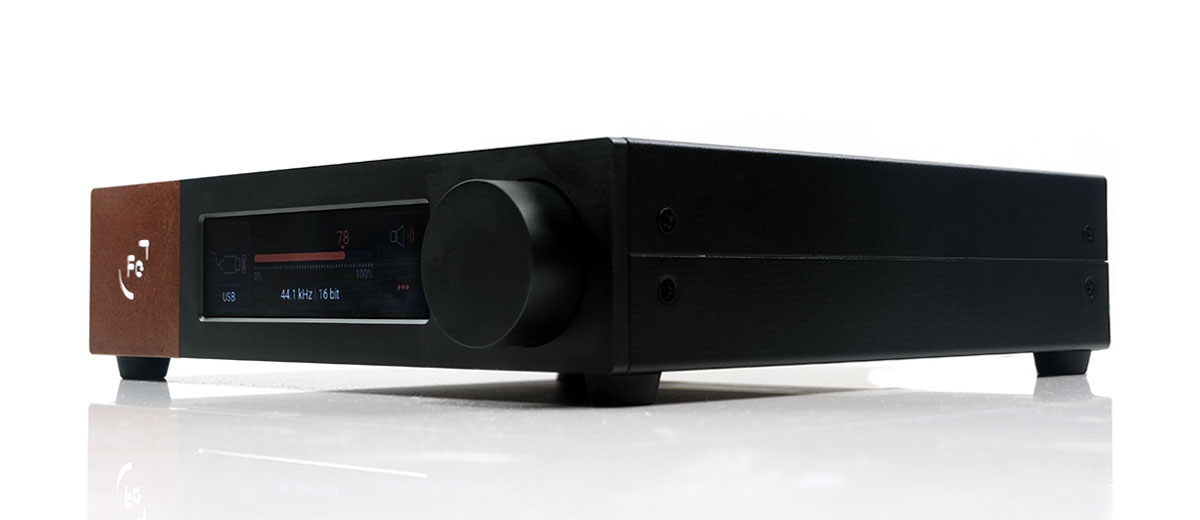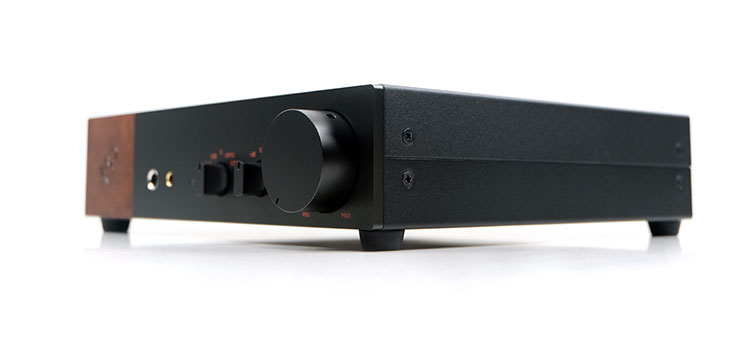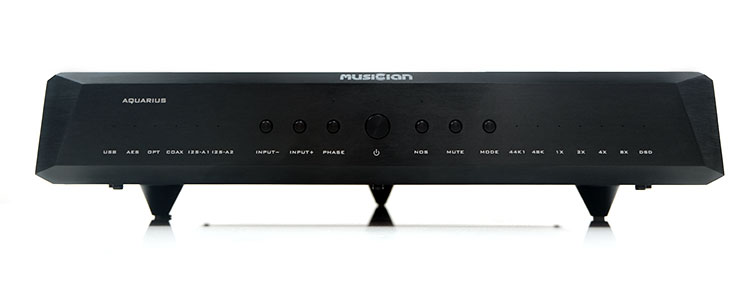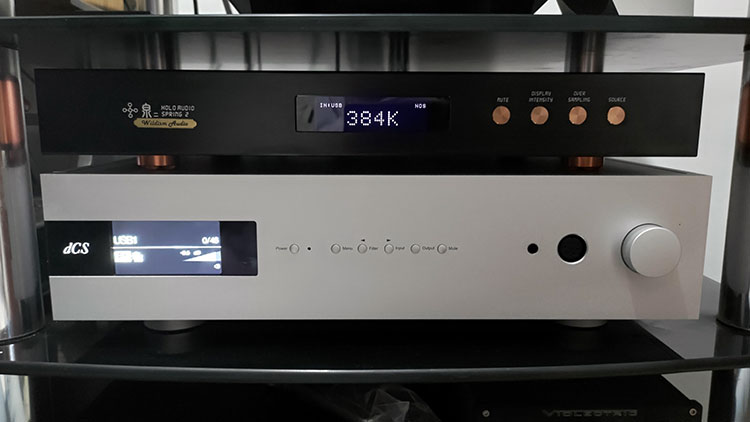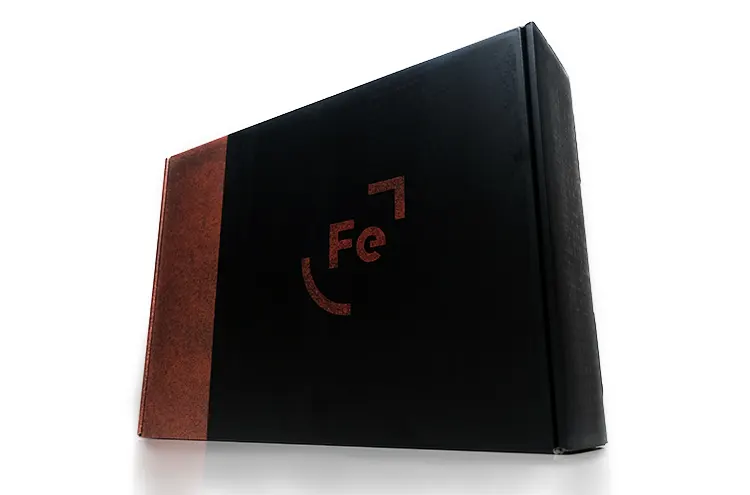Select Comparisons
The following comparisons to the Ferrum WANDLA GoldenSound Edition were completed using a mix of the Ferrum OOR/HYPSOS bundle and a USB connection from a Windows 10 laptop with Roon.
Headphones paired with the balanced output of the Ferrum OOR included the Abyss Diana MR and the Audeze LCD-5.
Ferrum ERCO (Gen 1)
Sadly no Gen 2 ERCO here, so paper stats only when referenced. Perhaps soon we can remedy the performance impressions in a future review.
The ERCO Gen 1 was launched in Mid-2022 with the now cheaper Gen 2 out at the tail-end of 2023. The Gen 1 was also our Top Gear 2022 Best Desktop DAC/Amp award winner for 2022.
Note, that my focus is purely on the DAC performance side for this comparison.
Technical
The ERCO is an integrated desktop DAC and headphone amplifier designed to stack comfortably with HYPSOS and even output to the OOR if required or purchased as a standalone system unit for headphone users.
Up until the release of the WANDLA pairing the ERCO with the OOR was the only way to get a Ferrum ‘system’ so to some extent the ERCO now goes back to its original ‘all-in-one’ purpose.
The ERCO decoding setup does have some commonality in topology design with the WANDLA though at a slightly lower end of the scale.
Like the WANDLA it is a single chipset delta-sigma setup with an independent I/V implementation. However, its choice of the Sabre ES9028PRO DAC chipset is a step below and cheaper than the WANDLA’s ES9038PRO.
The Gen 1 decoding is also technically one step below at DSD256 and PCM 32BIT/384kHz compared to DSD512 and PCM 32BIT/768kHz but it can natively unfold and render MQA 8X if that is still important to you.
The ERCO Gen 2 matches the WANDLA at PCM 768 kHz and DSD 512 with an improved SERCE’s DSP engine performance allowing for oversampling using the WANDLA’s HQ Apodizing digital filter
As a reminder, the WANDLA GoldenSound has ditched MQA but you can still find it in the cheaper stock WANLDA version. Both units are compatible with HYPSOS with a dedicated setting which you can choose when powering up the HYPSOS unit.
Design
The ERCO design language and form factor are the same as those of the WANDLA GoldenSound Edition. It’s compact, with similar dimensions, and weighs the same at 1.8 kg. It is also made of matte black corten steel for the housing with a rustic brown dash on the front panel’s left side.
Technically, you can stack this on top of the WANDLA, OOR, and HYPSOS to form a rather tall quad stack and it will still grip the table in a rock-solid manner.
The big difference is the lack of an interactive panel on the ERCO and let me tell you that makes a big difference.
The WANDLA GoldenSound Edition’s responsive touchscreen and informative well-designed UI make for a far more engaging user experience. The inclusion of a remote control with the WANDLA magnifies this advantage over the ERCO.
Not that the ERCO lacks features. Its I/O is not far from the WANDLA if we look at them as DACs. Rather the interaction is just a bit blander with its OOR-like front facia of rotating switches and the potentiometer on the far right-hand side.
The I/O that the ERCO Gen 1 lacks is the WANDLA’s inclusion of an AES socket, HDMI ARC, and an I²S input. The ERCO’s physical brightness and bypass controls are now set within the WANDLA’s touchscreen software UI.
Performance
For this comparison, I kept HYPSOS tied to the OOR and powered the WANLDA GoldenSound Edition and the ERCO with their power bricks in bypass mode using their respective balanced analog outputs. I also kept the WANDLA in Red output mode as opposed to Pro.
No question the WANDLA GoldenSound Edition is the better performer here. The Diana MR/OOR pairing sounded far livelier and more dynamic in its delivery. The presentation was more immersive yet at the same time the control and separation were superior to the ERCO.
The ERCO sounded softer overall, lacking the same firm low-end punch and creating a subjective opinion of my recordings sounding somewhat slower and warmer in their bass delivery.
From what I was hearing the ERCO pairing felt a little more closed in and I did find myself turning up the volume subconsciously to try and match the verve and holographic performance of the WANLDA performance.
And that was before I started applying the new filter or DSP options. The bass line of the WANDLA GoldenSound is already deeper and more aggressive but with Impact+ it was even beefier sounding to my ear.
The Spatial Enhancement option also seemed to tease out more impact around the Diana MR’s upper mids and lower treble. The ERCO has a similar tonal quality in the same region but it sounded duller, not as well-defined, or as physical in the percussion strike notes.
Overall, I can see why the WANDLA GoldenSound is costlier and rated higher than the ERCO First Gen. Quite how the ERCO 2 performs in this matchup remains to be seen but the gap to overcome is substantial.
Musician Audio Aquarius
Another high-end DAC launched in 2022, the Musician Audio Aquarius is derived from the Denafrips Terminator and was reviewed by us in the same year
Technical
The Aquarius is a very different proposition. This is a ‘high-end’ R-2R DAC as opposed to the delta-sigma ES9038PRO chipset inside the WANDLA GoldenSound Edition.
Internally, it consists of four ladder rails of discrete 24BIT resistors. Each is handpicked to within 0.005% precision resistance for core R2R native 1BIT PCM decoding capability with an additional ladder for 6BIT DSD processing, (32 steps FIR Filters).
The decoding ceiling is monstrous for the Aquarius with rates of up to PCM 32BIT/1536kHz and DSD1024 via USB and I²S. However, you do need a dedicated Thesycon software driver to get it up and running on Windows but once running you have a lot of decoding headroom.
Both DACs do have sampling options but in the case of the Aquarius, it is more limited to the typical NOS/OS. The WANDLA GoldenSound has a much more in-depth DSP experience including its ‘Elevated Digital Headroom’ processing which might handle oversampling in a more refined manner.
A potential drawback of the Aquarius, similar to the smaller Pegasus version, is the more limited balanced lineout Vrms capability compared to the WANDLA.
The Aquarius’s balanced maximum output is 2.66Vrms for DSD up to 3.59Vrms for PCM (balanced). The WANDLA GoldenSound Red is still on par at 3.5Vrms in Red but by switching to the Pro mode you power amp-friendly 8Vrms output.
If relevant to your usage needs, the Aquarius dual I²S is compatible with Cayin sources. This was not the case when I tested the N7 and N8ii mini HDMI output with the WANDLA GoldenSound edition.
Design
Side by side, the Aquarius is bigger and heavier than the WANDLA GoldenSound Edition. This bad boy is made for stacking but ideally, as the first building block because it is much too big to sit most components save perhaps for a dCS Bartok.
The aesthetics are cool, though. I like the angular brushed aluminum front plate with discreet mechanical buttons and the unique tripod pillar support. I suggest not putting any weight on the device that is off-center, as you can tip it quite easily.
The Aquarius control system is not as modern as the WANDLA touchscreen and some of the linear navigation through the input options is tedious. However, it can be faster with a quick button press giving you an instant feature or mode change.
The Aquarius lacks a remote control, though, which is a drawback for HiFi users. Its user manual is also abysmal, especially regarding NOS/OS mode clarity, which can be confusing to the eye as to which is on, though not to the ear.
The Aquarius’s I/O is good, with balanced and single-ended analog outputs and a wide range of digital inputs. However, it does not have a preamp capability, and it cannot accept an analog line-in, either, with no volume or voltage control. It also uses a standard USB-B input, which lacks OTG compatibility.
The big draw for me is the dual I²S on the Pegasus which is compatible with a wide range of sources, including Cayin. The WANDLA has opted for a more modern ARC instead of dual I²S giving it an additional home entertainment dimension.
Performance
For this comparison, I kept the WANDLA GoldenSound Edition in bypass and red mode using the OOR balanced output for DACs and the Diana MR as my test headphones.
This is more of a fair fight than the ERCO comparison. Dynamic range is almost on par, maybe just a slight edge to the blacker background of the WANDLA GSE when things go a bit quieter in recordings but otherwise the performance and volume headroom are quite evenly matched.
Where they differ is their tonal and imaging emphasis, and even here I can tweak that a little to bring them closer with some DSP.
The WANDLA GoldenSound Edition default output is ‘delta-sigma’ to me, though a very good one, one of the most natural I have heard. Yet it still has a fairly polished and precise tone compared to the more textured, analog note quality of the Aquarius.
The tonal output of the Aquarius is also sweeter sounding and a little more relaxed and spacious in its delivery than the WANDLA/ORR pairing using the Diana MR. Noticeably so on vocal mixes that veer to the brighter side with sibilance baked into the sound.
Recordings like this are why I have DACs such as the Aquarius which soften that harmonic dissonance and produce a more even-harmonic, agreeable quality to recordings.
The stock WANDLA GoldenSound will not shy away from that sibilance, call it more accurate if you will but the same recording’s sibilance is noticeably sharper with the MR.
However, switch on the Tube Mode and all that sharpness drifts away beautifully. You will not get the sweetness of the Aquarius, the GSE in Tube mode is more robust to my ear, but that sharp overtone is virtually gone leaving a smoother sound.
Holo Audio Spring 2 (Wild Edition Extreme)
This was a private purchase a few years back and thus never officially reviewed though often referenced and compared to in my reviews.
There is a more recent Spring 3 release from Kitsune with this Wild Edition Extreme of Spring 2, a specially upgraded version from Wildism Audio HK.
Technical
The Spring 2 is another R2R DAC and a well-regarded one in the audiophile community.
The Spring 2 is a 24-bit discrete R-2R design for PCM and a discrete Ladder DAC optimized architecture for DSD rather than the delta-sigma ES9038PRO inside the WANDLA.
The stock Spring 2 is powered by O-Ring toroidal transformers with linear regulators for a stable and clean power supply. My Extreme Edition goes further with a 100va Pure Silver Transformer with additional Xsymphony Pure Silver Litz Wire internal wiring and plenty of upgraded Audionote Kaisei caps.
As with the Musician Audio, the Spring 2 decoding ceiling is higher than the WANDLA GoldenSound Edition at up to DSD1024 native via a dedicated 6BIT ladder networks and PCM via the main networks up to 32BIT/1536k. That drops to 24BIT/192k PCM and DSD64-DoP for its coaxial and optical inputs.
Filters are there for both units though, like the Aquarius, the Spring 2 options are just NOS/OS and NOS/OS in either PCM or DSD mode, nothing quite as rich in DSP as the WANDLA GoldenSound feature set.
For lineout, the Holo Audio will offer a little more than the WANDLA GoldenSound’s Red mode’s 1.75/3.5Vrms at 2.5/5Vrms for single-ended and balanced analog output options but does not have the Pro balanced mode 8Vrms capability.
This is only a benefit if your amplifier can handle the additional Vrms otherwise 2/4Vrms is perfectly fine from the Holo Audio DAC. There is no variable volume pre-amp control on the Spring 2 DACs so it’s fixed voltage only.
Design
If you can view the picture above then you know the Spring 2 DAC is big and hefty at 9 kg though relatively shallow in terms of depth. It is a far bigger form factor than the diminutive 1.8 kg WANDLA GoldenSound Edition chassis.
Coincidentally, both devices use a bronzed color scheme for their aesthetics though the Holo Audio’s nuanced button shaping and dot matrix display give it a very different vibe.
Both DACs have decent-sized LCD screens but only the WANDLA offers touch capability and to be honest, the Ferrum version has a more in-depth and enjoyable UI menu system.
This version of the Spring series DACs has no pre-amp or volume control capability. If that is a requirement then the WANDLA GoldenSound is the correct choice between these two.
The Spring 2 offers XLR and RCA in SE and balanced line out but no analog input capability. Digital I/O also differs slightly. Both DACs have AES and I²S but instead of a modern HDMI ARC, the Spring 2 offers 2 coaxial inputs, one of which is BNC.
Thankfully, the Spring 2 also has a beautifully finished aluminum remote control so both DACs can be operated as part of a proper HiFi system.
Setup
For this comparison, I went with the LCD-5 and the OOR (+dB)/HYPSOS combo and a balanced connection to the Spring 2 and the WANDLA GoldenSound Edition DACs.
The WANDLA was kept in Red mode with its lineout on bypass and the Spring 2 was set to NOS mode. Both DACs pulled from a PC Roon core via USB.
Performance
The LCD-5 is a bit of an equalizer for this comparison due to its rather rounded and intimate soundstage quality. Nevertheless, you can still hear a wider soundstage from the Spring 2 pairing than the stock performance of the WANDLA.
Without DSP, the WANDLA GoldenSound Edition has better depth and height, more treble extension, and a blacker background. It’s more precise sounding with a slightly shorter level of decay to create an enhanced perception of space but a comparatively reduced level of width is noticeable.
The game changer is the Spatial Enhancement DSP mode on the GoldenSound Edition. Not so much that it pushes everything out to the sides but rather background spatial cues are more observant at the extreme ends giving the entire soundstage a more complex and filled-in quality.
When that is on I think the quality and definition of the peripheral instruments, including pan and scan note movement sequences, sound more nuanced with more character and more articulate in their delivery.
The Spring 2 remains wide but slightly less articulate, perhaps a bit more one-dimensional on how those supporting notes or instruments are separated.
The tonal coloration of the Spring 2 is a little more to the natural side with less contrast than the WANDLA. You do not get the same punchy character but it is a little warmer through the upper bass and lower-mids with a more even-harmonic midrange timbre.
You can add the tube mode to enhance that GSE smoothness and it does help with sharper-sounding treble recordings but at the cost of a little bit of treble extension. The Holo Audio Spring 2 still retains great extension but for the lows and highs, it tapers off ever so slightly with a stronger midrange focus.
My Verdict
The Ferrum WANDLA GoldenSound Edition DAC is a top-quality performer but also a DAC with features that I find incredibly useful.
It delivers a natural to neutral tonal quality that gels well with a wide range of amplifiers and loads of sound tweaks which can further fine-tune the performance for an almost perfect match.
I still hear that delta-sigma quality with a subtle polish to the sound but only when ranged against flagship R2R performers. Against other delta-sigma DACs such as the ERCO Gen 1 it far outperforms it both in accuracy and dynamic range.
I would also like Ferrum to figure out a way to enhance the compatibility of their I²S pin configuration to include Cayin’s I²S-equipped devices. This was a big miss during my testing as it’s my digital input of choice.
HYPSOS owners will benefit from connecting the WANDLA to it but not quite as big a leap in performance as the OOR/HYPSOS performance. Still, with the new dual DC coupler output HYPSOS being sold, it’s a no-brainer to plug both units into it and get all the possible upgrades.
All in all, this is the best and most complete pure DAC feature-wise I have heard to date in 2024.
Ferrum WANDLA GoldenSound Edition Specifications
- DAC chip: ESS Sabre ES9038PRO
- DAC resolution: 768 kHz / 32 bit, DSD 512
- Digital inputs:
• USB Type-C (up to PCM 768 kHz / 32 bit, DSD 512, DoP 256)
• I2S (up to PCM 768 kHz / 32 bit, DSD 512, DoP 256), PS Audio® compatible
• ARC (up to PCM 192 kHz / 24 bit), TV input with CEC
• AES (up to PCM 192 kHz / 24 bit, DoP 64)
• Coaxial S/PDIF (up to PCM 192 kHz / 24 bit, DoP 64)
• Optical S/PDIF (up to PCM 96 kHz / 24 bit*)
*may work up to PCM 192 kHz and DoP 64 – depending on the customer’s optical cable and transmitter - Analog inputs: RCA
- Analog input Vmax: 9.5 VRMS (2 – 3.5 VRMS recommended)
- Analog input impedance: 47 kΩ
- Line outputs: balanced XLR, unbalanced RCA
- Volume control: analog with bypass option / digital for DAC operation only
- Output level (@ 0 dBFS / 1 kHz sine):
• PRO: 8 VRMS balanced, 4 VRMS unbalanced
• Red Book: 3.5 VRMS balanced, 1.75 VRMS unbalanced - Frequency response: 10 Hz – 200 kHz +/- 0.1 dB analog inputs
- DAC THD: -121 dB (0.00009 %), THD+N: -115 dB unweighted
- Analog input THD: -123 dB @ 2 VRMS
- Dynamic range (A-weighted): 127 dB analog, 119 dB digital
- Crosstalk: -120 dB for 1 kHz, better than -100 dB for 20 Hz – 20 kHz
- Output impedance: 22 Ω unbalanced, 44 Ω balanced
- Power consumption: 10 W idle, 15 W max
- Power inputs (22-30 VDC):
• 5.5/2.5 mm DC connector, center positive
• proprietary Ferrum Power Link (FPL) 4-pin DC connector - Power adapter: 100-240 VAC to 24 VDC
- Remote control: included
- Dimensions: 21.7 cm x 20.6 cm x 5 cm / 8.6″ x 8.1″ x 2.0″
- Weight: 1.8 kg / 3.97 lbs

